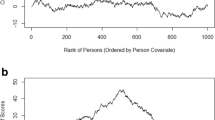Abstract
Chapters 1 and 3 through 6 describe a number of especially attractive features of the Rasch model (RM). These assets - in particular, sufficiency of the unweighted raw score, existence of conditional maximum likelihood estimators of the model parameters and of conditional likelihood ratio tests for hypothesis testing - suggest the question as to whether they are shared by a larger class of IRT models, or whether they are, within a certain framework, unique properties of the RM. In the latter case, we would have to conclude that the RM plays a rather singular role within IRT. As we shall see, this is actually so. The derivations in this chapter lay a foundation both for the RM and for the metric scale properties of Rasch measurement.
In this chapter, some algebraic properties of the condition likelihood function of the Rasch model, described in Chapter 3, are used; readers not familiar with these properties may wish to read Chapter 3 prior to Chapter 2.
Access this chapter
Tax calculation will be finalised at checkout
Purchases are for personal use only
Preview
Unable to display preview. Download preview PDF.
Similar content being viewed by others
Author information
Authors and Affiliations
Editor information
Editors and Affiliations
Rights and permissions
Copyright information
© 1995 Springer-Verlag New York, Inc.
About this chapter
Cite this chapter
Fischer, G.H. (1995). Derivations of the Rasch Model. In: Fischer, G.H., Molenaar, I.W. (eds) Rasch Models. Springer, New York, NY. https://doi.org/10.1007/978-1-4612-4230-7_2
Download citation
DOI: https://doi.org/10.1007/978-1-4612-4230-7_2
Publisher Name: Springer, New York, NY
Print ISBN: 978-1-4612-8704-9
Online ISBN: 978-1-4612-4230-7
eBook Packages: Springer Book Archive




